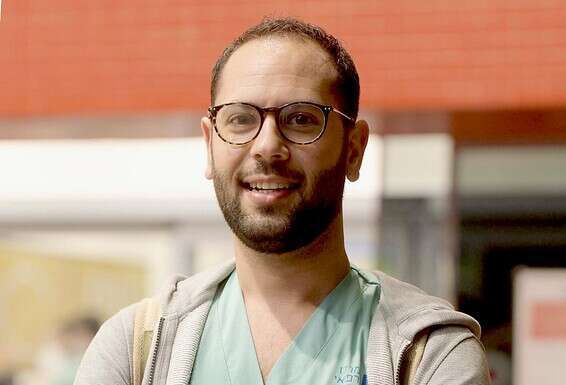The feeling when entering the American University in Jenin can be confusing. The atmosphere and spoken language is Arabic, the culture is Palestinian, the teaching language is English, yet a large number of students are Arab Israeli. They amount to about half of the 12,000 that studied there last year. That is more than the 5,400 studying at Haifa University or the 3,000 at Tel Aviv University, making the campus in Jenin the largest Arab Israeli campus in the world.
But Jenin is just the tip of the iceberg of a much wider phenomenon. Last year about 15,000 Arab Israeli students studied abroad or over the Green Line - half of them in the Palestinian Authority. This trend is shaping the nature of Arab society in Israel, but for some reason, it is being ignored by the wider public.
Follow Israel Hayom on Facebook and Twitter
It's somewhat of a triple failure: The students pay tens of thousands of shekels a year in tuition in private or semi-private institutions - money that could have benefitted the Israeli higher education system; they are exposed to studies and culture that are different to the Israeli experience, and sometimes hostile towards it; and they are forced to pass difficult licensing tests when they return to Israel, which creates a deep sense of unfairness. The greatest absurdity of all is that most of them are absorbed into the Israeli workforce. In fact, the Israeli higher education system - especially in the medical and paramedical fields - has become a bottleneck and obstacle to social mobility, precisely for one of the populations that need it most.
"I enrolled for teaching studies in Israel, but understood it wasn't for me," says Ali Zabidat, 28, who today works as a nurse in the Assaf Harofeh Medical Center. "I wanted to learn nursing, but my grades weren't good enough so I preferred to go to Jordan." Zabidat studied at Amman University, and in order to pay his tuition, he worked during vacations in an aluminum factory in Haifa. According to him, it was a good experience and the return to Israel was successful.
To Germany and back to the Middle East
In 2019 the accountant general in the Finance Ministry wrote a report on "Obstacles to Integrating the Arab Population in Higher Education." According to the report, about 80 percent of students studying in Jenin focus on medical fields, 31 percent of them in nursing, 18 percent in occupational therapy, eight percent in social and environmental health, and seven percent in dentistry, physiotherapy, and radiography.

These numbers are similar to those in other institutions and the reason is, according to the report, "significant lack of correspondence between the number of Arabs interested in studying health professions in Israel and the limited availability of places to study these fields in universities." In other words, more demand than supply. However, the fact that most of those who study abroad do eventually find jobs in Israel shows that the lack of availability does not reflect the needs of the market.
"My kids study abroad," says Anan Darawshe, who owns a consulting firm for candidates who wish to study abroad, "and my son's dream was to learn medicine, but admission was very difficult in Israel. You need a score of 730 in the psychometric test and another written test and personal interview. The language is very important and many people stumble there. Those who don't find themselves in Israel go outside, and abroad there's a wide array of institutions. Most look for a place with low tuition fees, so many first went to the Eastern bloc - Ukraine, Moldova and such, where tuition is $4,000-6,000 a year and the cost of living is very cheap."
But due to problems in the level of studies, since 2019, Israel recognizes only those who study in OECD countries. "That caused a lot of problems," says Darawshe, "those countries are expensive and have occupancy limits. That's why in the past few years many have gone to study in Jordan and the Palestinian Authority. Because of the peace agreements with Jordan and the fact the universities there have US recognition, the Israeli Health Ministry recognizes it. The level there is fairly high because they filter out a lot of students. The problem is that tuition is high there, about $16,000 a year."
Professor Kussai Haj-Yehia, a lecturer and Head of the Arab Academic Institute in Beit Berl College did his PhD in the 1980s in Germany. "When I returned to Israel and searched for a job, everyone asked me where I studied because they respect people who studied in Israel," he says and adds "there is a preference for graduates of Israeli institutions and after that the US and UK." After he found out that no one had ever studied the reasons for these preferences, he decided to research the topic. "I began my research at Tel Aviv University and did my post-doctoral degree on Arab academics who studied in Germany."
Yehia divides the phenomenon into three waves: The first was in the 1970s, when Arab Israelis - a few dozen a year - went to study in the USSR, with funding from the Israeli communist party. The second wave started in the 1980s when many wished to study medicine and the focus moved to Germany (about 2,000 students a year). "The studies there were free," he says "most of the Arab students from Israel got scholarships from German funds - not because we're Arab or Palestinian, but because we're Israeli. Because of the historical background, the Germans wanted to help Israelis."
The third wave came with the collapse of the Soviet Union. "The cost of living began to rise and so did hostility towards foreigners. So they went to Italy, Romania and Hungary, mainly medicine and paramedicine," Yehia said. "After the peace agreements with Jordan and the Council for Higher Education recognition of studies there, the trend changed. In 2009, when we researched it, there were 5,400 students in Jordan. I called it 'from Germanization to Jordanization of higher education.'"
The continuation of that wave came in 2014, with the move to the Palestinian Authority. "At universities in the PA there are now over 8,200 students," says Haj Yehia, "and in Jenin alone there are about 6,000 Arab Israelis. At An-Najah in Nablus there are 1,800 students from Israel, 800 in the Faculty of Medicine. Others are in Abu Dis in Jerusalem and many - about 1,000 students - have started learning in Hebron, mostly residents of the Negev. There's no medicine department, so they study education, religion, languages, etc."
Yehia estimates that this year over 20,000 Arab Israelis are studying abroad, compared to only a few thousand Jewish Israelis - the opposite of their share in the population (80:20 towards Arab). "We are beating you abroad," he says with a grin.
A cultural and intellectual meeting
Haj Yehia says that in interviews he has held with hundreds of people, most say they would have preferred to study in Israel: "They go through a Via Dolorosa, they're disconnected from their family, and to pay for it they need a lot of money. The annual cost in the Palestinian Authority, including living, can reach NIS 70,000. Some even sell plots of land to pay for this, and after that, there's the licensing issue."
Q: How do the studies abroad affect students from cultural and identity perspectives?
"There is influence of the culture of Palestinian students, but it's minor. Their objective is to eventually return to Israel, so it's minor. There's an intellectual and cultural meeting. There is that connection, but whoever studies medicine isn't really exposed to cultural or religious content. Each student must take a basic course on Arab and Islamic culture, but the influence is minor because everyone wants to be a doctor."
But a glance at the curriculum of the Arab American University in Jenin shows there is definitely exposure to a clear Palestinian and anti-Israeli narrative. Each student in paramedical and other fields must pass a prerequisite course of "Palestinian studies" of two weekly hours, in which they learn also about "the European incursion and the Zionist settlement," "Dispossession of Palestinian land," "The Palestinian resistance movement 1936" (known in Israel as the 1936 Riots), and more. As part of the elective courses of "The elements of Islamic education" and "Islamic Culture" there is also "Israel and Zionism studies," "The Palestinian prisoners' movement," and "Jerusalem: Civilization and History."
Many of whom we spoke to don't give much weight to these influences. "It's like Jewish studies at Bar Ilan," say people who follow the phenomenon in Israel, "something that needs to be passed but not taken too seriously. It's not like in Tel Aviv or on Mount Scopus they would learn something more Zionist." And yet, Israel misses the opportunity to give these citizens elementary knowledge and a less hostile narrative and a possibility for networking and connection with Israeli colleagues.
It seems the cultural influence is stronger in social contexts. In Haj Yehia's study "New cultural meetings since 1948" published in the Journal of Applied Research in 2016, this issue came up often in discussions with interviewees. For example, Mahsan, a dentistry student from Umm el Fahm, says "the atmosphere is Palestinian and reminds me of my national atmosphere. I didn't hear a lot about Palestine, but I learn about it here."
Asan from Qalansawe, a nursing student in Jenin, says: "You feel comfortable when you're in Palestinian surroundings that approve of your traditions and thoughts, that you can't find in Israeli institutions." Sana from Nazareth, a nursing student, says: "There I feel my Arab nationalism."
"It's a shame, with our own hands we're missing a huge opportunity to educate a whole generation of young Israelis," says a former senior official in the Ministry of Education who dealt a lot with the challenges of the Arab society, "we have the possibility to increase the integration and decrease the alienation and tensions, but we prefer to let the Palestinian elite educate the youth."
A disconcerting aspect of this phenomenon is in fact the level of study abroad. The Head of the Medical Professions Licensing Division in the Health Ministry, Prof. Shaul Yatziv, headed a delegation to observe the popular institutions in Eastern Europe and their level of study, the curriculum and the level of clinical experience in hospitals, and came back with worrying findings. For example, some Armenian institutions where Israeli students studied that were not even recognized by the local government.

"Our responsibility is first and foremost the health of the Israeli public," says Yatziv, "and because of the nature of medicine studies there is great importance to clinical experience in hospitals, to watching closely the discretion of senior doctors and their coping with actual problems." Therefore, he believes, it's not enough to hold certification exams in order to solve the problem, there must be supervision of the programs in the institutions themselves. As part of the reform being led by the ministry, from this year anyone who does not study in one of the recognized institutions will not be able to take certification exams in Israel.
Subscribe to Israel Hayom's daily newsletter and never miss our top stories!
The Council for Higher Education has impressive data on encouraging higher education in the Arab sector. High schools and communities have managed to double the number of Arab students in Israeli institutions from 22,543 (in 2008) to 48,627 (in 2018), including a significant rise in hi-tech professions, and even considerable improvement amongst ethnic Bedouins. The rate of Arab Israelis amongst the overall student population is 17 percent, close to their share in the population.
But these numbers, as impressive as they may be, don't solve the brain drain overseas. Even the CHE admits that when it comes to medical and paramedical fields they have a problem, and when it comes to studying abroad, their efforts have almost no influence.
The white paper of the account general in the Finance Ministry recommends enlarging the number of studying availabilities in Israel. "Enlarging supply inside Israel," it said, "will allow supervision of the quality of study, will strengthen the correlation between the studies and the needs of the Israeli health system, will raise the gross national product thanks to services that are now being 'imported' from abroad which will be be provided by Israelis, and could ease the integration of Arab youth in the Israeli society and economy."
In that context, the Jordanian model could make for interesting inspiration. According to Darawshe, in Jordan there are two routes: "Whoever doesn't have much money but has good grades goes the usual route of subsidized studies. Whoever doesn't, goes to the parallel program, semi-private, with higher tuition, where the admission standards are lower."
As for the claims that the medical schools in Israel should be made bigger, Prof. Yatziv says: "Everyone wants more students in Israel. There's no argument. But we mustn't compromise on the level. From my familiarity with the medical faculty and the ground, our problem is not the classrooms but the abilities to carry out adequate clinical training in the hospitals." According to him, that's where the bottleneck is: "We need more teaching positions, more beds. In the end, that's what's holding us back."




